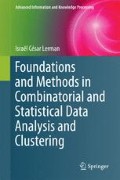Abstract
Let us recapitulate briefly the development of the previous chapters. As emphasized above (see Sect. 3.5.4 of Chap. 3), given a set \(\mathcal {A} = \{ a^{1}, a^{2}, \ldots , a^{j}, \ldots , a^{p} \}\) of descriptive attributes, description may concern a set \(\mathcal {O} = \{ o_{1}, o_{2}, \ldots , o_{i}, \ldots , o_{n} \}\) of elementary objects or a set \(\Gamma = \{ C_{1}, C_{2}, \ldots , C_{i}, \ldots , C_{I} \}\) of categories or classes. In Sect. 4.2 of Chap. 4 we studied the problem of the definition of a similarity index between objects or attributes when \(\mathcal {A}\) is constituted by Boolean attributes. In this analysis several facets are considered: combinatorial, metrical, ordinal and statistical. We saw in Sect. 4.2.1.3, how to transpose a similarity index between objects defined in the framework of Boolean description, to the case of description by numerical attributes. Conversely, we have transposed a similarity or distance function defined on \(\mathcal {O}\) in the case of numerical description to that where \(\mathcal {A}\) is a set of Boolean attributes.
Access this chapter
Tax calculation will be finalised at checkout
Purchases are for personal use only
Notes
- 1.
The notations used here are somewhat different from those of [7].
References
Bacelar Nicolau, H.: Two probabilistic models for classification of variables. In: Bock, H.H. (ed.) Classification and Related Methods of Data Analysis, pp. 1981–1986. North-Holland, Amsterdam (1988)
Bacelar Nicolau, H.: Classifying integer scale data by the affinity coefficient. Methods Oper. Res. 60, 587–595 (1990)
Bacelar Nicolau, H., Costa Nicolau, F., Sousa, F., Bacelar Nicolau, L.: Clustering variables with a three-way approach for health sciences. Test. Methodol. Psychom. Appl. Psychol. 4, 435–447 (2014)
Barthélemy, P., Leclerc, B., Monjardet, B.: Quelques aspects du consensus en classification. In: Data Analysis and Informatics. North-Holland, Amsterdam (1984)
Diday, E.: Croisements, ordres et ultramétriques : application à la rechercherche de consensus en classification automatique. Rapport de recherche 144, INRIA (1982)
Goodall, W.D.: A new similarity index based on probability. Biom. 22(4), 882–890 (1966)
Goodall, W.D.: Probabilistic indices for classification—some extensions. Abstr. Bot. 17(1–2), 125–132 (1993)
Gower, J., Legendre, P.: Metric and euclidean properties of dissimilarity coefficients. J. Classif. 3, 5–48 (1986)
Lerman, I.C.: Sur l’analyse des données préalable à une classification automatique; proposition d’une nouvelle mesure de similarité. Mathématiques et Sciences Humaines 32, 5–15 (1970)
Lerman, I.C.: Classification et analyse ordinale des données. Dunod and http://www.brclasssoc.org.uk/books/index.html (1981)
Lerman, I.C., PETER, P.: Classification en présence de variables préordonnance taxonomiques à choix multiple. application à la structuration de phlébotomes de la guyanne francaise. Publication Interne 426, IRISA-INRIA (1988)
Lerman, I.C., Peter, P.: Indice probabiliste de vraisemblance du lien entre objets quelconques; analyse comparative entre deux approches. Revue de Statistique Appliquée, (LI(1)), pp. 5–35 (2003)
Lerman, I.C., Peter, P.: Representation of concept description by multivalued taxonomic preordonance variables. In: Cucumel, G., Brito, P., Bertrand, P., Carvalho, F. (eds.) Selected Contributions in Data Analysis and Classification, pp. 271–284. Springer, Heidelberg (2007)
Lesot, M.-J., Rifqi, M., Benhada, H.: Similarity measures for binary and numerical data. Int. J. Knowl. Eng.Soft Data Paradig. 1, 63–84 (2009)
Massé, J.R.: Classes de tableaux équivalents en analyse descriptive multidimensionnelle des données. Application à l’ étude de mesures statiques sur circuits intégrés logiques. Ph.D. thesis, Université de Rennes 1, Octobre (1978)
Matusita, K.: Cluster analysis and affinity of distributions. In: Barra, J.R. et al. (ed.) Recent developments in Statistics, pp. 537–544. North-Holland, Amsterdam (1977)
Régnier, S.: Sur quelques aspects mathématiques des problèmes de classification automatique. I.C.C. Bull. 4, 175–191 (1965)
Rohlf, F.J.: Consensus indices for comparing classifications. Math. Biosci. 59, 131–144 (1982)
Sneath, P.H.A., Sokal, R.R.: Numerical Taxonomy. Freeman, San Francisco (1973)
Author information
Authors and Affiliations
Corresponding author
Rights and permissions
Copyright information
© 2016 Springer-Verlag London
About this chapter
Cite this chapter
Lerman, I.C. (2016). Comparing Objects or Categories Described by Attributes. In: Foundations and Methods in Combinatorial and Statistical Data Analysis and Clustering. Advanced Information and Knowledge Processing. Springer, London. https://doi.org/10.1007/978-1-4471-6793-8_7
Download citation
DOI: https://doi.org/10.1007/978-1-4471-6793-8_7
Published:
Publisher Name: Springer, London
Print ISBN: 978-1-4471-6791-4
Online ISBN: 978-1-4471-6793-8
eBook Packages: Computer ScienceComputer Science (R0)

